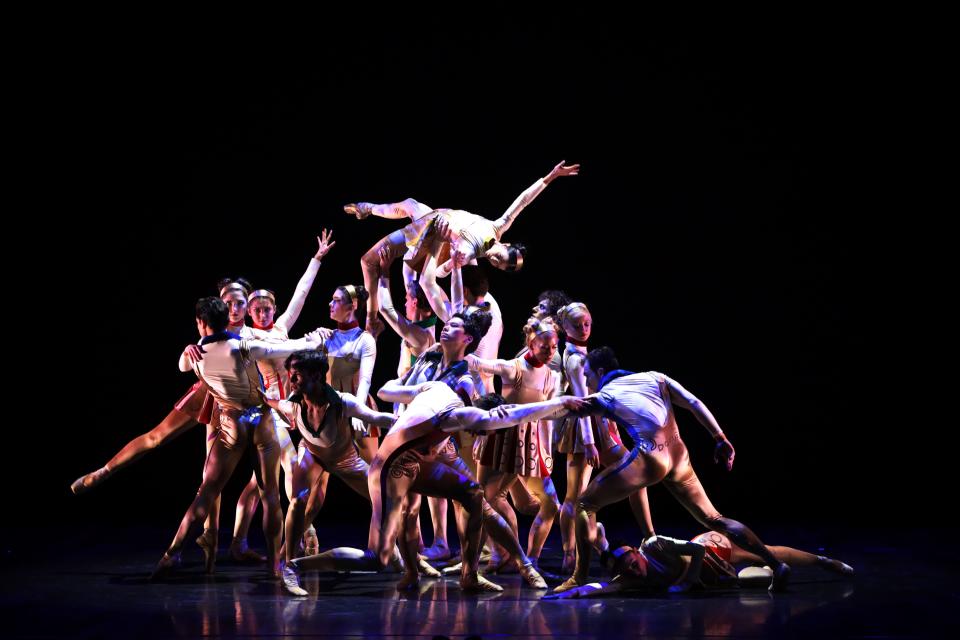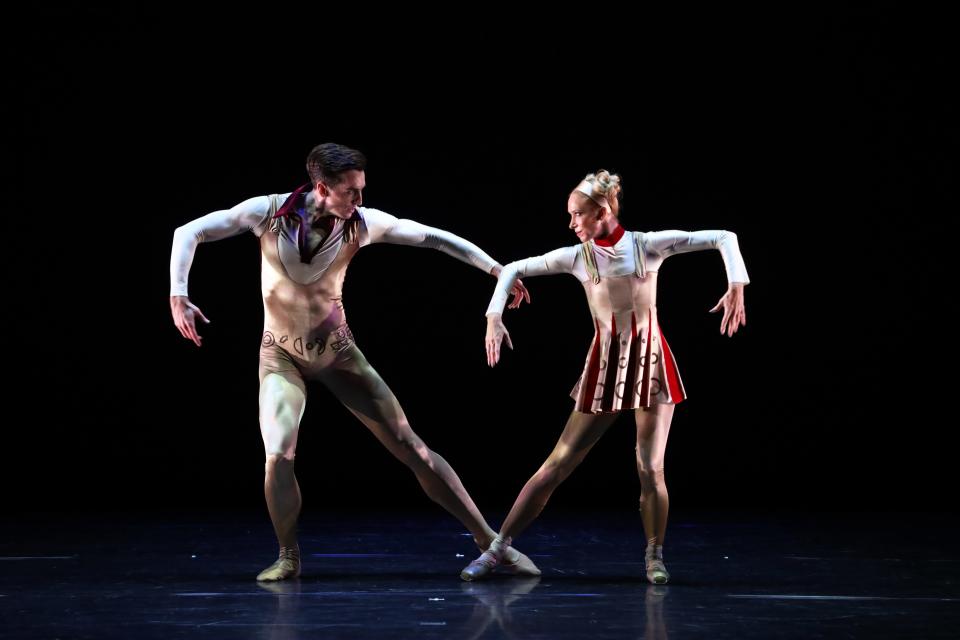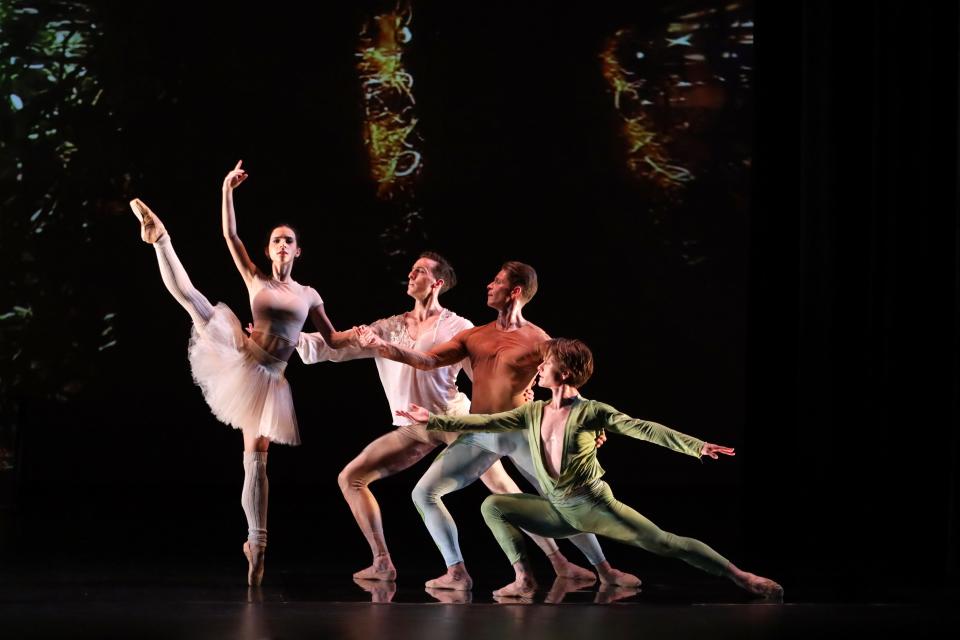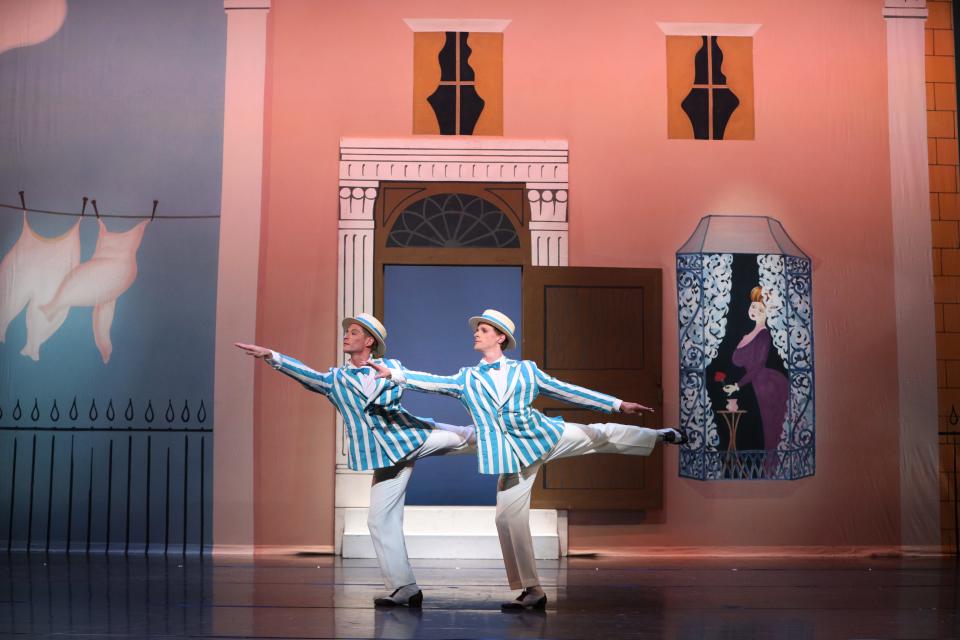Sarasota Ballet premiere stretches dancers and viewers alike
In musical theater, a “triple threat” is a gifted actor who is equally talented at singing and dancing. So what do you call an accomplished dancer who is also adept at choreographing and composing music?
Arcadian Broad.
Broad debuted his newest work, “Frequency Hurtz,” at the FSU Center for the Performing Arts Friday night and no matter what the Sarasota audience thought of it – a more accessible reprise of the comic Frederick Ashton chestnut, “Façade” seemed to earn more exuberant applause – there was no denying that this 26-year-old soloist, who joined the company from the Orlando Ballet in 2021, has an unusually mature and distinctive voice and vision.
Arts NewsletterSign up to receive the latest news on the Sarasota area arts scene every Monday
Supporting new workSarasota Ballet dancer finds the right ‘Frequency’ for new choreography
Theater, dance, music, art and moreYour February guide to 60-plus arts events in the Sarasota-Manatee area

But then, Broad is hardly a typical 26-year-old. At 13 he appeared on “America’s Got Talent,” at 15 his first piece of serious choreography made him a YouTube sensation and at 16 he became the youngest dancer ever to receive a contract with Orlando Ballet. There he became the company’s artist in residence and created two full-length ballets for which he also composed the scores. (For “Frequency Hurtz, his friend Jeremy Studinski shares the musical credit.) By his own accounting, this is his 35th work.
In program notes, Broad describes his newest ballet as an exploration of audio and visual frequencies that will be perceived differently by each viewer. The title is a play on the word Gigahertz, a unit of frequency typically used to measure computer processing speeds and electromagnetic currents. The alternative spelling is clever but not particularly accurate. There is nothing painful about experiencing this work.
I was fascinated by his unusual and not always “pretty” movement vocabulary, definitively driven by a score that ranges from repetitive, percussive electronic beats to simple harmonic melodies, with periodic punctuations of dialogue in a Germanic accent. An intimate knowledge of composition can be a tremendous boon for a choreographer; George Balanchine almost obsessively studied scores before stepping into the studio. Broad took up the piano at age 2 and his musical maturity serves his purpose here well.
Comprised (according to program notes) of eight movements, progressing through the Ghz spectrum from zero to 1000, it opens with all but one of the cast of 16 dimly visible in frozen postures upstage. Brilliantly lit downstage and center is junior principal Richard House – all 6-foot-3-inches of him – who begins to twitch, gyrate and visually vibrate as we hear a scholarly voice discussing energy, frequency and “the secret to the universe.”
'A real concern'How Sarasota arts groups are trying to attract younger audiences
A major boostNew Sarasota performing arts center receives second $10 million gift
ReviewJoyful ‘Silent Sky’ inspires pride and heartwarming spirit at Asolo Rep

As we progress to higher frequencies, different groups of dancers internalize and interpret the sounds individually, punctuated by rare moments of unity and communion. Just before the full cast culmination – which Broad intends to represent “the full audible spectrum” – there is a humorous moment when the frequency pitch apparently becomes untenable, the disembodied voice shouts “Relax!” and the dancers fall on their backs to the floor.
Visually, the impact is magnified by the alternately stark and shadowy lighting (by Ethan Vail) which makes the costumes by John Dunnett – unitards for the men and short, pleated jumpers with colored insets for the women that evoke both Renaissance attire and children’s play clothes – seem to shimmer with a glow of their own.
The dancers who stood out were those with the maturity and confidence to step outside a classical vocabulary and let loose with an internally catalyzed movement. House, Taylor Sambola-Broad (the choreographer’s wife) and the remarkably versatile Danielle Brown (her hair a cross between Princess Leia and an adolescent’s pigtails) were particularly effective.

If Broad’s ballet tested the limits of a viewer’s intellect, comprehension and open-mindedness, Jessica Lang’s “Shades of Spring,” a commission that premiered last summer at The Joyce Theater in New York, was more easily digested. With a plethora of eye-catching, artful group poses, it’s a pretty ballet and humble in its pretentions. Video projections of nature by Roxane Revon (watery plant roots, leaves and blossoms, a green glade) and a raked platform with a mirrored surface upstage right on which the members of the cast of seven periodically lounge or pause to watch others, set the tone for choreography that is based in classicism but also draws from the natural world. (At one point Broad and Yuki Nonaka, squished together on all fours, become a crawling insect.)
Likewise, the costumes (by Jillian Lewis) are a mix of classical and modern, formal and informal – Marijana Dominis sports a traditional tutu that is offset by bulky legwarmers and a stomach-baring bra top – and the music, buoyant selections from Haydn, contribute to an upbeat, contemporary effect. While injuries precluded the participation of principals Ricard Graziano and Ricardo Rhodes, the fresh energy of their replacements was perfectly suited to a piece that is inventive, yet comfortingly familiar.

The reprise of Ashton’s “Façade,” the choreographer’s take on the popular social dances of his day, concluded the triple bill. Though I’ve seen and enjoyed the piece often before, after the imaginative innovations that had come before, its inclusion on the program seemed a dissonant afterthought, its charms forced and contrived.
It did serve to underscore, however, the growing versatility of the company’s repertoire and its eagerness to continue stretching the limits of its dancers and its audiences. To my mind, that can only be a good thing.
‘In Rep’
Sarasota Ballet. Reviewed Jan. 27. FSU Center For the Performing Arts, 5555 N. Tamiami Trail, Sarasota. Through Monday. Tickets start at $35. 941-359-0099; sarasotaballet.org
Contact Carrie Seidman at carrie.seidman@gmail.com or 505-238-0392.
This article originally appeared on Sarasota Herald-Tribune: Sarasota Ballet gets on a new frequency with world premiere

 money
money 